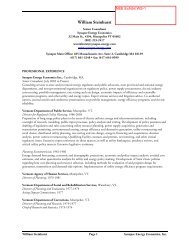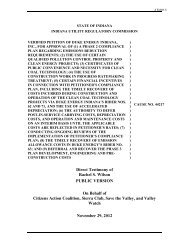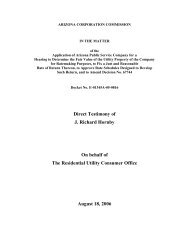Best Practices in Energy Efficiency Program Screening - Synapse ...
Best Practices in Energy Efficiency Program Screening - Synapse ...
Best Practices in Energy Efficiency Program Screening - Synapse ...
You also want an ePaper? Increase the reach of your titles
YUMPU automatically turns print PDFs into web optimized ePapers that Google loves.
Discount Rate: The discount rate used to calculate present values of costs and benefits<br />
has significant implications for the cost-effectiveness of energy efficiency programs.<br />
Many states use the utility weighted average cost of capital for a discount rate.<br />
However, the energy efficiency activities are a low-risk <strong>in</strong>vestment for most energy<br />
efficiency program adm<strong>in</strong>istrators, and thus a lower discount rate would be appropriate.<br />
Cost-Effectiveness Screen<strong>in</strong>g Level: Cost effectiveness can be determ<strong>in</strong>ed at either the<br />
measure level, program level, or at the portfolio or plan-wide level. Of these options,<br />
measure level screen<strong>in</strong>g is the strictest application for determ<strong>in</strong><strong>in</strong>g cost-effectiveness,<br />
and often leads to limited programs and sav<strong>in</strong>gs. We are aware of at least one state that<br />
screens for cost effectiveness at the measure level and is experienc<strong>in</strong>g difficulty<br />
justify<strong>in</strong>g certa<strong>in</strong> measures, <strong>in</strong>clud<strong>in</strong>g <strong>in</strong>sulation <strong>in</strong> home energy retrofits. While such<br />
measures provide significant levels of sav<strong>in</strong>gs, especially when comb<strong>in</strong>ed with other<br />
measures or efficiency efforts, the program adm<strong>in</strong>istrators cannot <strong>in</strong>clude uneconomic<br />
measures <strong>in</strong> their efficiency plans, and are therefore compelled to reduce their program<br />
offer<strong>in</strong>gs and overall sav<strong>in</strong>gs.<br />
Measure Life: Implement<strong>in</strong>g energy efficiency programs requires upfront spend<strong>in</strong>g, while<br />
the measures <strong>in</strong>stalled through the programs produce sav<strong>in</strong>gs over the course of their<br />
useful lives. Depend<strong>in</strong>g on the measure, the useful life can be as long as 20 years or<br />
more. Some states artificially truncate the years of benefits that can be <strong>in</strong>cluded <strong>in</strong> costeffectiveness<br />
screen<strong>in</strong>g (e.g., only 15 years of sav<strong>in</strong>gs can be accounted for). Such an<br />
approach skews the cost-benefit analysis because it limits the full amount of benefits<br />
result<strong>in</strong>g from efficiency efforts.<br />
This report addresses these and other issues, and recommends best practices that<br />
regulators, program adm<strong>in</strong>istrators, and other efficiency stakeholders can adopt for<br />
appropriate efficiency program screen<strong>in</strong>g.<br />
Illustrative Examples<br />
For many of the topics discussed below, we provide an illustrative example that<br />
demonstrates the issue and highlights the effect of apply<strong>in</strong>g the recommended best<br />
practice. The illustrative examples are based on an actual efficiency portfolio provided<br />
by an electric utility <strong>in</strong> New England, <strong>in</strong>clud<strong>in</strong>g the utility’s efficiency budget, sav<strong>in</strong>gs,<br />
measure life, avoided costs, and other factors. We reference the same utility <strong>in</strong> each<br />
example for consistency.<br />
Appendix A <strong>in</strong>cludes a description of the programs that are offered by this example<br />
utility. Figure 1.1 below provides a summary of the actual levelized cost of saved energy<br />
for each of these programs, relative to the avoided cost cap that is currently be<strong>in</strong>g used<br />
by this utility. Each program’s energy sav<strong>in</strong>gs are presented <strong>in</strong> the width of the<br />
program’s bar, and each program’s levelized cost is demonstrated by the bar’s height.<br />
(The costs and avoided costs presented <strong>in</strong> this figure are limited to those that are<br />
<strong>in</strong>cluded <strong>in</strong> the <strong>Program</strong> Adm<strong>in</strong>istrator Cost test, i.e., just the electricity-related costs and<br />
benefits.)<br />
As <strong>in</strong>dicated <strong>in</strong> Figure 1.1, these programs are all well below the avoided cost of<br />
electricity, with the exception of one of the low-<strong>in</strong>come programs. (This low-<strong>in</strong>come<br />
program is cost-effective under the Total Resource Cost test, because of the low-<strong>in</strong>come<br />
other program benefits. We will address this issue <strong>in</strong> Section 4.1.) The average cost of<br />
the energy efficiency portfolio as a whole is well below the avoided costs, with an<br />
average levelized cost of 3.4 cents per kWh.<br />
| 10 <strong>Best</strong> <strong>Practices</strong> <strong>in</strong> <strong>Energy</strong> <strong>Efficiency</strong> <strong>Program</strong> Screen<strong>in</strong>g | www.nhpci.org







